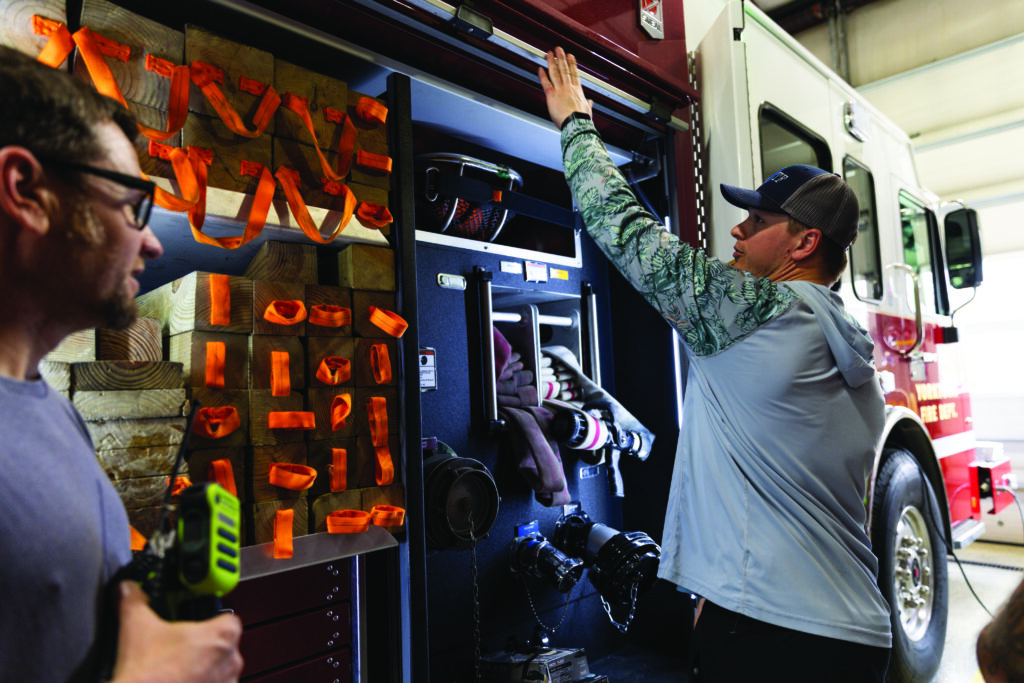Career day in elementary school was an exciting day for Jeremiah Mckeighen. He originally wanted to be a taxi driver because he wanted to “help people get around,” but his passion for assisting people soon developed into becoming a firefighter.
“I’ve always had a desire to help people,” Jeremiah says.
Jeremiah recalls attending a funeral for a local firefighter who had passed away, remembering the uniforms that the firefighters were wearing during the ceremony. He wanted to wear that uniform one day.
“I got to the point where firefighting and medical stuff is the best way I can do that,” Jeremiah says, now having worked for the Cowan Volunteer Fire Department in Muncie, Indiana, for about a year as a volunteer firefighter.
In Indiana, 72.6% of U.S. Fire Administration-registered fire departments are volunteer-based. In 2020, of the 29,452 United States fire departments, only 18% of those departments were career or mostly career departments, according to the National Fire Protection Association.
To become a volunteer firefighter, volunteers need to take two classes in the state of Indiana, Firefighter I and II, in order to get certified. Students are taught fire science, fire extinguishment, search and rescue, ventilation, vehicle extraction, as well as many other topics. This class is taught two nights per week for five months for student certification. Students are also required to complete a medical class to acquire their medical certification.
The Yorktown Fire Department has been a volunteer fire department since 1913. The department has an average of 1,200 calls per year, providing services that range from basic life support, water rescues, structural collapses, emergency medical situations, and many other services.
Public Information Officer Blair Webster has worked at the fire station for two years and is in charge of all public media relations regarding the department. He is also a firefighter and EMT for the organization.
Blair emphasizes volunteer firefighters undergo the same training as career firefighters. However, according to the National Library of Medicine, volunteers do not receive a salary for their work, unlike career firefighters, but may receive certain benefits such as health insurance, life insurance, or other nominal fees.
After taking a public safety class at his local career center as a high school student, Jeremiah grasped an understanding of what it takes to become a firefighter. He says a lot of time is spent preparing to wear and lift the firefighter gear.
“A lot of training involves being able to go from clothes to full gear and ready to go on a truck in two minutes,” Jeremiah says.
Fire and Rescue and EMT instructor at the Muncie Area Career Center and Assistant Chief of the Yorktown Fire Department, Christopher Horner, has been teaching fire safety since 2009. Christopher says 25% to 30% of his students go into volunteer firefighting.
“[Instructors] are passing [training abilities] down in every succeeding generation, just better, and that gives me hope for the future,” Christopher says.
Christopher emphasizes the importance of teaching his students proper fire safety, after recounting a call he and his team took back in 2019 regarding a house fire. Three people lost their lives amidst the fire, causing Christopher to change the way he looked at his job. He shares that in his experience, firefighting was all “fun” until experiencing events that showed him “things are at stake.”
“It was kind of a sobering moment of, if things don’t go well, there are consequences,” Christopher says.
He continues to explain that he doesn’t want his students to go through something similar. To avoid this, Christopher says he does the best job he can to pass his knowledge on to the younger generation of firefighters, wanting to be that person others can “look up to.” Being part of a team and working together is how Christopher knows he can help people.

“I need a team, and so my job is to create that team for myself and everyone else out there that needs it,” Christopher says.
Even though 70% of firefighters in the U.S. are volunteers, according to the U.S. Fire Administration, there are still challenges many of these departments face. According to Blair, a prevalent issue is recruiting people for their department.
“Some of the biggest challenges we face is getting people to come do this job for little to no money,” Blair says. “[Volunteer firefighters] have full-time jobs, and it’s whenever people are available is when they’re able to make runs and make calls.”
Jeremiah shares that many volunteer firefighters with families sometimes have to bring their children to the fire station with them. As a single parent himself, Jeremiah says a personal challenge is making sure he is fit enough to do the necessary work for being a firefighter while also juggling parenting because he has a kid that “looks up” to him.
Seeing first hand how volunteer firefighting can impact families, the Cowan Volunteer Fire Department stresses keeping family a priority, and the department typically invites a spouse to come with their partner to the job interview so they fully grasp the impact that this job could have on their spouse.
“It could very easily be a call where a person doesn’t come back,” Jeremiah says.
Along with struggling recruitment for volunteer fire departments, departments often lack funding.
“Our budgets might not be as big as places around us, hence why we’re voluntary fire departments,” Blair says. “We’re blessed in Yorktown, [Yorktown] has funded us very well. There are several departments that don’t have quite the funding that we do.”
The International Fire Chief Association shared the average cost for full equipment is $9,410, not including many of the tools they need.
Christopher explains volunteer fire departments across the country are “nationally in trouble.” He emphasizes factors such as inflation, time management, and prior commitments, such as jobs and families, are making it more difficult to be a volunteer firefighter. Christopher expresses that he doesn’t know how much longer certain volunteer fire departments are going to stay volunteer, explaining that it just “isn’t cost effective.”
In 2023, Governor Eric Holcomb and the Indiana Department for Homeland Security secured state funding totaling $17.7 million for fire training and equipment, according to the Indiana Government website. While not all volunteer fire departments have received funding, the ones that have are determined by how old their equipment is and if the department has a lower-income than others.

Since many fire departments do not receive funding from the state, events and fundraisers help raise money for firefighters to get equipment and other things. Currently, the Yorktown Fire Department has no upcoming fundraisers, but the fire department has previously hosted 5K races as well as other fundraising events to raise money.
Blair also comments that the public doesn’t realize that the Yorktown Fire Department is a volunteer fire department. He says that “a lot of it is for at-home response” in regards to volunteers taking calls from their homes, emphasizing that volunteers are doing this work out of the “goodness of their heart.”
“They think that this is a full-time department with staffing 24/7, 365 [days],” Blair says.
Hours for each firefighter vary by department, Jeremiah says. At Cowan, it depends on where you live in regard to the fire station. If a volunteer lives outside Cowan, that individual needs to dedicate around twenty hours a week to the station. If a volunteer lives near or in Cowan, they need to respond to at least 20% or more of calls, Jeremiah says.
While many volunteer departments are still trying to find new ways to improve funding and expand their budgets, Blair shared a little support goes a long way.
“Just support your local volunteer fire departments in any way you can,” Blair says. “Get out and help support these volunteer fire departments and your community.”
Sources: U.S. Fire Administration-registered fire department, National Fire Protection Association, National Library of Medicine, U.S. Fire Administration, International Fire Chief Association



